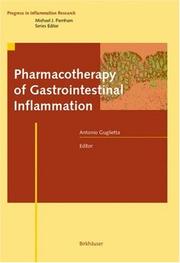| Listing 1 - 10 of 26 | << page >> |
Sort by
|

ISBN: 0397516258 Year: 1997 Publisher: Philadelphia New York Lippincott-Raven
Abstract | Keywords | Export | Availability | Bookmark
 Loading...
Loading...Choose an application
- Reference Manager
- EndNote
- RefWorks (Direct export to RefWorks)
Book
Year: 2020 Publisher: Basel, Switzerland : MDPI - Multidisciplinary Digital Publishing Institute,
Abstract | Keywords | Export | Availability | Bookmark
 Loading...
Loading...Choose an application
- Reference Manager
- EndNote
- RefWorks (Direct export to RefWorks)
This book presents some of the state-of-the-art methods for the study of the gastrointestinal variables affecting oral drug absorption. Practical applications of new in vitro release/dissolution methods are presented, as well as in vitro permeability studies to explore segmental differences. The application of MRI methods for the study of colon physiology is presented to illustrate its potential applications in controlled release dosage form design. Some examples of successful in vitro-in vivo correlations show how implementing the gastrointestinal physiological variables in the new in vitro methods can improve the predictions of in vivo drug product performance. The book contains an updated review of the experimental, computational, and in vivo approaches for measuring intestinal permeability.
Gastrointestinal agents. --- Gastrointestinal agents --- Research.
Book
Year: 2020 Publisher: Basel, Switzerland : MDPI - Multidisciplinary Digital Publishing Institute,
Abstract | Keywords | Export | Availability | Bookmark
 Loading...
Loading...Choose an application
- Reference Manager
- EndNote
- RefWorks (Direct export to RefWorks)
This book presents some of the state-of-the-art methods for the study of the gastrointestinal variables affecting oral drug absorption. Practical applications of new in vitro release/dissolution methods are presented, as well as in vitro permeability studies to explore segmental differences. The application of MRI methods for the study of colon physiology is presented to illustrate its potential applications in controlled release dosage form design. Some examples of successful in vitro-in vivo correlations show how implementing the gastrointestinal physiological variables in the new in vitro methods can improve the predictions of in vivo drug product performance. The book contains an updated review of the experimental, computational, and in vivo approaches for measuring intestinal permeability.
Gastrointestinal agents. --- Gastrointestinal agents --- Research.
Book
Year: 2020 Publisher: Basel, Switzerland : MDPI - Multidisciplinary Digital Publishing Institute,
Abstract | Keywords | Export | Availability | Bookmark
 Loading...
Loading...Choose an application
- Reference Manager
- EndNote
- RefWorks (Direct export to RefWorks)
This book presents some of the state-of-the-art methods for the study of the gastrointestinal variables affecting oral drug absorption. Practical applications of new in vitro release/dissolution methods are presented, as well as in vitro permeability studies to explore segmental differences. The application of MRI methods for the study of colon physiology is presented to illustrate its potential applications in controlled release dosage form design. Some examples of successful in vitro-in vivo correlations show how implementing the gastrointestinal physiological variables in the new in vitro methods can improve the predictions of in vivo drug product performance. The book contains an updated review of the experimental, computational, and in vivo approaches for measuring intestinal permeability.
Gastrointestinal agents. --- Gastrointestinal agents --- Research.
Book
ISBN: 9781118481578 1118481577 Year: 2014 Publisher: Chichester, West Sussex: Wiley-Blackwell,
Abstract | Keywords | Export | Availability | Bookmark
 Loading...
Loading...Choose an application
- Reference Manager
- EndNote
- RefWorks (Direct export to RefWorks)
"Learn all you need to know about gastrointestinal drugs and their clinical use with this one-stop, rapid reference pocket guide. Brought to you by many of the world's leading GI drug experts, Pocket Guide to Gastrointestinal Drugs provides comprehensive guidance to the pharmacological properties of drugs used to treat gastrointestinal conditions, including mechanisms of action, appropriate administration, and potential adverse effects associated with their use. Organized by class of drug and ranging from PPIs to immunosupressants, each chapter first examines the specific agents within that class and then their appropriate and judicious use across a range of specific GI disorders. Key features include: - Introduction of drug class, - Basic pharmacology, including mechanism of action, bioavailability, metabolism, interactions, adverse effects, toxicity, and special considerations, - Dosing information for each GI condition and on- and off-label use, - Consistent use of both generic and trade names throughout, - Specific reference to drug use in pediatric patients and during pregnancy. Perfect for quick consultation on the wards and in the office, Pocket Guide to Gastrointestinal Drugs is the ideal tool for all those managing patients with GI conditions, including gastroenterologists, GI trainees, emergency physicians, GI specialist nurses, primary care physicians and residents, intensivists and pharmacists"--Provided by publisher.
Gastrointestinal Agents --- Gastrointestinal Agents --- Gastrointestinal Diseases
Book
ISBN: 0909220220 Year: 1977 Publisher: Toorak, Vic. : Excerpta Medica,
Abstract | Keywords | Export | Availability | Bookmark
 Loading...
Loading...Choose an application
- Reference Manager
- EndNote
- RefWorks (Direct export to RefWorks)
Dissertation
Year: 2003 Publisher: Leiden s.n.
Abstract | Keywords | Export | Availability | Bookmark
 Loading...
Loading...Choose an application
- Reference Manager
- EndNote
- RefWorks (Direct export to RefWorks)
Gastrointestinal Agents --- Motilin --- pharmacology --- pharmacology

ISBN: 3764369108 9783764369101 Year: 2004 Publisher: Basel Birkhäuser Verlag
Abstract | Keywords | Export | Availability | Bookmark
 Loading...
Loading...Choose an application
- Reference Manager
- EndNote
- RefWorks (Direct export to RefWorks)
Gastrointestinal agents --- Gastrointestinal system --- Gastrointestinal Agents --- Gastrointestinal Diseases --- Diseases --- Chemotherapy --- drug therapy
Book
Year: 2010 Publisher: Bruxelles: UCL. Faculté de pharmacie et des sciences biomédicales,
Abstract | Keywords | Export | Availability | Bookmark
 Loading...
Loading...Choose an application
- Reference Manager
- EndNote
- RefWorks (Direct export to RefWorks)
Nowadays, obesity represents a major concern in the field of health. Indeed, this pathology is associated with a cluster of several metabolic disorders such as insulin resistance and type 2 diabetes. The low grade inflammation associated with obesity seems to play a critical role in the occurrence of these metabolic disorders. A particular environmental factor appears to be implied in the development of this low grade inflammation; namely the gut microbiota. Indeed, obese mice (nutritionally or genetically induced ) display changes in gut microbiota composition, and present an increase in plasma level of an inflammatory compound of bacterial origin, the lipopolysaccharide (LPS). This increase in plasma LPS (endotoxemia) is associated with an enhancement of intestinal permeability.In this work, we demonstrated that a selective modulation of gut microbiota by prebiotics participates to the improvement of intestinal barrier function and by this way. decreases systemic and hepatic inflammation associated with obesity in obese oblob mice.This decrease in intestinal permeability is associated with an increase in intestinal peptides produced by enteroendocrine L cells: glucagon-like peptide-] (GLP-1) and glucagon-like peptide-2 (GLP-2). The mechanism of the increased endogenous GLP-2 production by prebiotics involves an increase in enteroendocrine cells differentiation from stem cells, and more specifically an increase of L cells number per mucosal surface.The increase in endogenous GLP-2 production constitutes a particularly interesting target of choice since this peptide is able to maintain the integrity of intestinal barrier. Therefore, we postulated that GLP-2 plays a key role in the improvement of the intestinal barrier induced by a selective modulation of gut microbiota in obese mice. In order to test this hypothesis we specifically blocked GLP-2 action by using a specific GLP-2 receptor antagonist co-administrated with prebiotics in order to modulate the gut microbiota. As expected, the decrease in intestinal permeability induced by prebiotics was abolished by GLP-2 receptor antagonist. Thus, in this experiment, we show that the modulation of the gut microbiota in obese mice restores the intestinal barrier function by a GLP-2 dependent mechanism. We also demonstrate that GLP- 2 treatment in obese mice is able per se to lessen intestinal permeability but also endotoxemia in oblob mice and thereby lowers the inflammatory tone associated with obesity.Our data allow us to propose GLP-2 as a nove} target in the treatment of obesity and related disease. Interestingly, prebiotic compound which modulate the gut microbiota are able to increase the endogenous GLP-2 production, thereby improving inflammation associated with obesity. A l'heure actuelle, l'obésité constitue une préoccupation majeure dans le domaine de la santé. En effet, elle est associée à un ensemble de désordres métaboliques tels que l'insulinorésistance et le diabète de type 2. L'inflammation de faible intensité, présente dans l'obésité, semble jouer un rôle prépondérant dans le déclenchement de ces pathologies. Un facteur environnemental original paraît être impliqué dans le développement de ce phénomène inflammatoire particulier ; il s'agit du microbiote intestinal. En effet, les modèles d'animaux obèses (nutritionnel ou génétique) présentent non seulement une altération du microbiote intestinal mais également une augmentation de la concentration plasmatique d'un facteur proinflammatoire d'origine bactérienne, le lipopolysaccharide (LPS). Cette augmentation des taux plasmatiques de LPS (endotoxémie) est associée à une augmentation de la perméabilité intestinale.Dans le cadre de ce travail, nous avons démontré qu'une modification spécifique du microbiote intestinal induite à l'aide de prébiotiques chez des souris obèses permettait de restaurer la fonction de barrière de l'intestin et ainsi de diminuer l'inflammation systémique et hépatique associée à l'obésité. Cette diminution de la perméabilité intestinale est notamment associée à une augmentation de peptides intestinaux produits par les cellules entéroendocrines de type L: le glucagon-like peptide-1 (GLP-1) et le glucagon-like peptide-2 (GLP-2). L'augmentation de la production endogène de GLP-2 constitue une cible de choix particulièrement intéressante étant donné que ce peptide permet de maintenir l'intégrité de la barrière intestinale. Nous avons donc émis l'hypothèse que le GLP-2 jouait un rôle clé dans la restauration de la barrière intestinale induite par les changements spécifiques du microbiote chez des souris obèses. Afin de vérifier cette hypothèse, nous avons bloqué l'action du GLP-2 à l'aide d'un antagoniste spécifique de son récepteur chez des animaux obèses dont la flore intestinale est modifiée par les prébiotiques.Comme attendu, la diminution de la perméabilité intestinale dépendante des prébiotiques est abolie par l'antagoniste du GLP-2. Ces résultats suggérent que la restauration de la fonction barrière de l'intestin par la modulation de la flore intestinale implique le GLP-2. Nous avons également démontré qu'un traitement au GLP-2 chez les souris obèses permettait à lui seul de diminuer non seulement la perméabilité intestinale mais également l'endotoxémie et l'inflammation associées à l'obésité.Pour terminer, nous avons pu mettre en évidence, au cours de ce travail, que l'augmentation de la production endogène de GLP-2, induite par une modulation de la flore intestinale chez des souris obèses, est associée à une augmentation de la différenciation des cellules souches intestinales en cellules entéroendocrines et plus particulièrement à une augmentation du nombre de cellules entéroendocrines de type L par surface de muqueuse intestinale.En conclusion, une modification sélective et quantitative du microbiote intestinal à l'aide de prébiotiques exerce un rôle clé dans le maintien de la fonction barrière de l'intestin via des mécanismes impliquant les cellules entéroendocrines de type L.Le GLP-2, produit par ces cellules, pourrait constituer une nouvelle cible thérapeutique dans le traitement de l'obésité et des maladies associées. Les prébiotiques pourraient être une approche intéressante pour moduler ce peptide dans le cadre de cette pathologie.
Gastrointestinal Microbiome --- Obesity --- Gastrointestinal Agents --- Glucagon-Like Peptide 2
Book
ISBN: 9060167538 Year: 1979 Publisher: Leiden : Stafleu,
Abstract | Keywords | Export | Availability | Bookmark
 Loading...
Loading...Choose an application
- Reference Manager
- EndNote
- RefWorks (Direct export to RefWorks)
| Listing 1 - 10 of 26 | << page >> |
Sort by
|

 Search
Search Feedback
Feedback About UniCat
About UniCat  Help
Help News
News